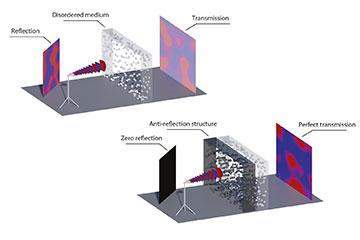Researchers have shown that a structure to cancel out scattering from a disordered medium can be designed based on the measured reflections from that medium rather than the medium’s structure. Placing the structure and the disordered medium together yields perfect transmission. [Image: P. E. Davy] [Enlarge image]
Scattering inside disordered media can lead to a variety of undesired effects, from poor radio reception to lack of visibility inside fog. Researchers in Europe have now shown how to all but eliminate such scattering by placing a second, carefully designed disordered medium between the wave source and the original scattering object—a result that they reckon could prove invaluable in mobile telephony, medical imaging and other applications (Nature, doi: 10.1038/s41586-022-04843-6).
Solving the back-reflection problem
Physicists have previously shown it is possible to overcome scattering inside disordered media by exciting light such that it passes through specific “open transmission channels” in otherwise opaque samples. However, this approach, which has proven effective in both optical and acoustic systems, only works for specific wave fields.
In the latest work, a team of researchers led by Stefan Rotter at the Vienna University of Technology, Austria, and Matthieu Davy at the University of Rennes, France, instead aimed to prevent back-reflection of any incident wave within a certain frequency band traveling toward a complex medium. Their idea was not to modify the medium itself but to combine it with a second, complementary medium, such that interference between waves from the two media reinforces transmission and blocks reflection—somewhat like the anti-reflection coatings applied to the surfaces of eye glasses.
The researchers developed an operational procedure that allowed them to cancel the back-reflection of any given disordered medium. Their scheme involves assembling the reflection matrix of the medium in question by measuring the amplitude and phase of the medium’s reflected light for various incoming and outgoing light fields. They found that, to remove back-scattering, the correcting medium needs to feature a reflection matrix that is exactly the transpose-conjugate of the one assembled for the disordered medium. This yields a scattered field that cancels back-reflection altogether in a very complex interference process, achieved without any knowledge of the structure of the given medium.
Canceling scattering effects
The challenge then is to design a correcting medium with the necessary properties. The researchers considered using a disordered medium consisting of a waveguide containing a certain number of randomly arranged Teflon and metallic cylinders. The task was to carry out an inverse design process of the correcting medium so that, starting with another random arrangement of Teflon and metallic cylinders, the scattering effects of the two lots of cylinders exactly cancel out. To accomplish this, the researchers used an iterative procedure in which they gradually reduced the difference between the calculated and desired scattering field from the correcting medium.
The researchers confirmed the viability of this approach through both computer simulation and experimentation—placing their correcting medium in front of the first waveguide and exposing it to microwaves at 7 GHz and 11.2 GHz. The simulations revealed that up to 99.9% of the incoming radiation should be transmitted with the correcting waveguide in place, as opposed to about only 50% transmission without it. This result was essentially confirmed by the experiments, although the transmitted fraction fell to between 90% and 94% because of losses from the microwaves’ interaction with the waveguide walls and cylinders.
Future applications
The researchers argue that, because only the reflective properties of the correcting medium need to be engineered, fabricating such devices from thin metasurfaces might be possible. This, they say, would allow anti-reflection structures to be tailor-made with potential variations in time domain so as to eliminate back-scattering from time-dependent media or moving objects.
Among the applications they envisage are energy harvesting, imaging techniques for use in areas such as biophysics or radar, and improvements to wireless communications. In particular, they say, such anti-reflection structures could be employed in 6G networks—the planned successor to 5G—given the need to minimize the power in radio signals from cell towers, which can, in principle, be done by better channeling the radiation.
Before any of this can happen, however, the researchers need to overcome a number of challenges. These include automating the design of the correcting medium—perhaps using machine learning—and adapting metasurfaces so that they can both measure a medium’s reflection matrix and then alter their own structure to perfectly counteract that reflection.


